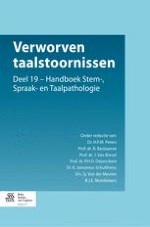Samenvatting
Afasie is een verzamelnaam voor taalstoornissen die het gevolg zijn van een beschadiging (laesie) van de hersenen. De meest opvallende symptomen van afasie doen zich voor bij het spreken. Veel voorkomende problemen zijn bijvoorbeeld het niet kunnen vinden van het juiste woord, het optreden van ‘versprekingen’ en moeilijkheden met het maken van zinnen. Daarnaast hebben afasiepatiënten vrijwel altijd moeite met het begrijpen van gesproken taal, maar deze problemen zijn in de regel minder opvallend en kunnen soms alleen met behulp van speciale tests worden aangetoond. Afasiepatiënten hebben tenslotte ook altijd moeite met lezen en schrijven en deze problemen vertonen vaak grote overeenkomst met die van respectievelijk het begrijpen en produceren van gesproken taal.
